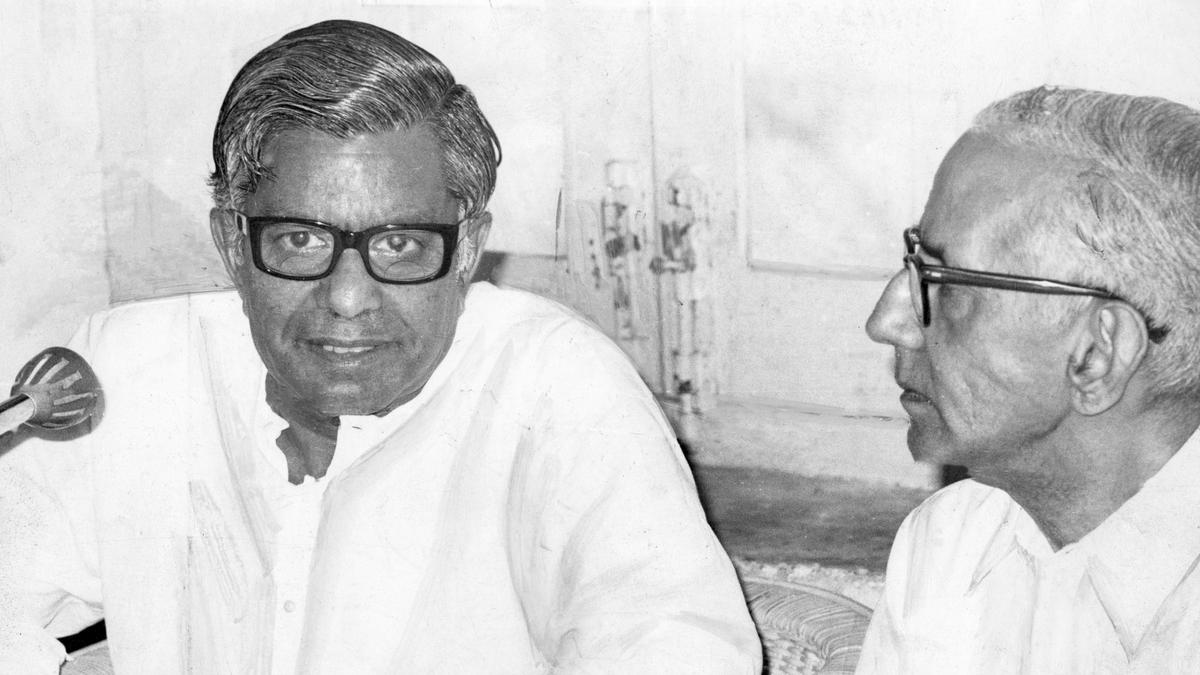
A scramble for rice when monsoon failed and rationing policy was introduced in early 1950s
The Hindu
Historic elections in Tamil Nadu shaped by rice shortage prompt policy changes, leading to successful decontrol of foodgrains.
Any discussion on the subject of rice in the public distribution system would prompt many to recall the outcome of the historic 1967 Assembly election in Tamil Nadu, wherein the problem of rice shortage played a big role in tilting the scales against the Congress government. But what is less discussed is that the 1952 Assembly election was also dominated by the same problem. As in 1967, the 1952 election saw the then Chief Minister, P.S. Kumaraswami Raja, and most of his Cabinet colleagues tasting defeat. M. Bakthavatsalam was one of the Ministers who lost (from Ponneri). Fifteen years later, as the last Congress Chief Minister of the State, he again lost — this time in Sriperumpudur. Talking of the 1952 election, C. Subramaniam, who became the Finance and Food Minister in the Ministry of C. Rajagopalachari (CR or Rajaji), in his memoirs ‘Hand of Destiny’ (volume 1), said the Congress had to pay “a very high price” in the election for pursuing the policy of rationing.
In the early 1950s, the Madras State encompassed several parts of the present-day Andhra Pradesh, Karnataka, and Kerala, in addition to Tamil Nadu. Rice and millets constituted the major foodgrains for people of the State. The problem of grain shortage was acutely felt even in 1950, as expressed by the then Governor, Krishna Kumarsingji Bhavsingji, in his visit to Thoothukudi in February that year. A news report, carried by The Hindu on February 22, 1950, said, “The monsoon had failed for a third year in succession and this, coupled with the recent cyclone in Andhradesa [referring to Telugu-speaking areas], had ‘a grave effect’ on the food situation.” Considering the situation, the Governor appealed to the people to take to non-rice diet.
Then, the system of rationing, introduced during the Second World War, was still in vogue. Except for half-a-dozen districts in the north and Thanjavur district in the central part, the remaining districts of the State, which faced a food production deficit, were dependent on supplies from surplus districts and on allocations by the Centre, according to an article in the Economic Weekly (precursor to the Economic and Political Weekly) of February 5, 1951. The deficit areas were called statutorily rationed areas where the government licensed private traders to open ration shops. Experts were still deliberating upon the pros and cons of the concept of ‘family ration cards’. What was in place then was ‘individual ration cards’.
In August 1950, the government had to tighten the supply by reducing the quantity of rice per adult per day from seven ounces (equivalent to 0.198 kg) to six ounces (0.17 kg) in the rationed areas, while keeping the overall quantity at 12 ounces intact, with the rest being covered in the form of wheat or ‘milo’. V.N. Swami, the 94-year-old Madurai-based veteran journalist, said the move had made the Congress members a subject of ridicule in the eyes of the people who were till then admirers of the party.
At that time, the system of paddy procurement was not prevalent. But, given the short supply of rice, farmers were required to surrender the quantity over and above what they required for their consumption. They were not permitted to remove their grain either until they surrendered the surplus quantities. Subsequently, from the arrangement of “total or intensive procurement”, the system of “levy” — surplus quantity, as assessed by local officials — came into force. There were severe restrictions on the inter-district movement of rice. The farmers considered the whole scheme oppressive. In February 1951, a legislator, P. Natesan, called for rice procurement even from Pakistan. In the same month, Kumaraswami Raja announced that there would be de-rationing in rural parts of the State, regardless of their being in surplus or deficit districts.
Commenting on the policy of rationing, Subramaniam mentioned that the implementation was left to “petty officials” and there was “a good deal of corruption in assessing the surplus. Big farmers had their surpluses estimated at a low level and gained much advantage”. On the restriction in removing foodgrains from the farms, he mentioned that the farmers had complained of “being treated as thieves” even with regard to their own farm produce, as the removal of grain before the surrender was made an offence. In cities too, the Congress government had earned the wrath of the consumers, who had to stand in ever-growing queues at ration shops. There were complaints of the shops selling poor quality rice. Naturally, hoarding happened and the price was perpetually on the rise. The former Union Minister added that when this matter was represented to the Chief Minister, he pleaded helplessness as the Centre had to give its nod.
It was no surprise that the ruling Congress, which faced the 1952 Assembly election against this backdrop, could not retain its majority. However, it emerged as the single largest party with 165 seats out of a total of 375. In April 1952, the Congress formed the government, headed by Rajaji.

While expressing happiness over the release of the pending 25% dues pertaining to bills for the completed civic works, contractors working under the Bruhat Bengaluru Mahanagara Palike (BBMP) termed the decision to withhold 5% as security against any defect found by Justice H.N. Nagamohan Das’ committee as unfair.

All India Kisan Sabha (AIKS) staged a demonstration in Thoothukudi against the Tamil Nadu government’s decision to classify agricultural lands owned by farmers in Keela Vilathikulam, Kathalampatti as temple assets, as well as to repeal the temple pattas of the lands which were taken from farmers of Vilvamarathupatti









